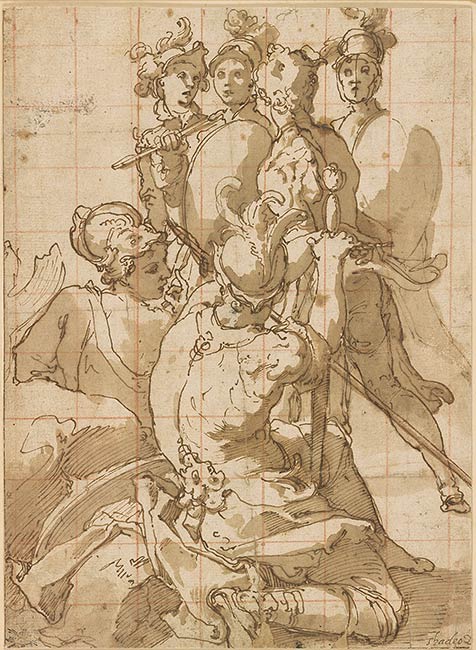
This drawing is a figure study for six soldiers just left of center in the foreground of the fresco depicting the Foundation of Orbetello in the Sala dei Fasti Farnesiani in the Palazzo Farnese, Rome. It was commissioned from Taddeo Zuccaro around 1563–65 in order to complete a fresco cycle left unfinished at the death of Francesco Salviati in 1563. The Morgan also owns a related compositional study (1973.28).
The scene in the fresco represents the (fictitious) founding of the city of Orbetello in the year 1100 by Pietro Farnese, captain of the papal cavalry. Taddeo had painted a similar scene in the Farnese villa at Caprarola, and that work’s inscription describes the event as “Pietro Farnese, having overcome and driven out the enemy of the Church, founds as a monument to his victory the town of Orbetello on the ruins of the Roman city of Cosa in the year of salvation 1100.”1 Although the Caprarola scene treats the same episode, it foregrounds the battle and is conceived as a tondo.2 Nonetheless, the town of Orbetello, built on a sand spit enclosed by two lagoons on the flat coast of Tuscany, is clearly seen in the background at upper left. Its founding in Roman times is illustrated in the middle distance at left by two oxen approaching an altar, which in the Morgan’s compositional drawing is inscribed Col[onia] Urbetell[i]. The episode, which was devised by Onofrio Panvinio (1530– 1568), a historian in the pay of Cardinal Alessandro Farnese, was probably intended to strengthen the family’s claims that, as abbot of Tre Fontane, Cardinal Farnese was also lord of Orbetello.
The Morgan drawings are two of four preparatory studies connected with the composition, but the Group of Four Soldiers is the only one not to map out the entire scene. Presumably the earliest is a rapid sketch by Taddeo in the British Museum, which differs from the final composition in that it shows Pietro Farnese and his retinue advancing from the left rather than the right.3 Taddeo must have drawn the Morgan compositional study next, as an intermediate solution. It is in the same direction as the fresco and similar in composition, with the exception of the foreground, which still lacks the onlookers. The soldiers carry a shield and banner covered with lilies, part of the Farnese coat of arms, which in the fresco are replaced by crossed keys beneath an umbrella, the insignia of a commander of the papal army. At this stage, Taddeo would have drawn the Group of Four Soldiers, which is preparatory for the repoussoir group at left that serves to enliven and deepen the composition. The soldier seen from the back—gracefully seated with his lower leg thrown back, turning to engage with his companion and resting on his sword—is one of the most beautiful inventions of Taddeo’s career.
In addition, the Berlin Museum possessed a fourth related design, now lost: a detailed, somewhat uninspired late compositional study. The drawing was known to John Gere through a photo taken around 1920 and shown to him by Hermann Voss.4 According to Gere, the ex-Berlin drawing closely resembled the fresco, differing only in the poses of two figures in the right foreground. He suggested that the study was from the hand of a workshop member, noting that on occasion the role of Taddeo’s assistants was not limited to the execution of the frescoes. Although he always accepted the attribution to Taddeo of the British Museum drawing and the Morgan Group of Four Soldiers, he in one instance described the Morgan compositional drawing as a “borderline case” yet later included it among the autograph drawings.5 Nonetheless, it should be considered fully rehabilitated even though it lacks the calligraphic flourish and liveliness so typical of Taddeo’s early exploratory works and figure studies owing to its different purpose. It is, however, the vigorous, unfettered pen line and inventive poses of the figure drawings, as seen here, which exerted a defining and lasting influence on a younger generation of draftsmen and which still dazzle collectors today.
—REP
Footnotes:
- Acidini Luchinat 1999, 1:222n79.
- Acidini Luchinat 1999, 1:183.
- British Museum, London, inv. 1947,0412.154.
- Gere 1969, no. 108.
- Gere 1969, 122; Gere 1970, 128 (as Taddeo, without further qualifications).
Watermark: none visible through lining.
This drawing is a preparatory study by the artist for six soldiers in the foreground, just left of center, of the fresco "The Foundation of Orbetello", executed ca. 1563-65 in the Sala dei Fasti Farnesiani, Palazzo Farnese, Rome.
Inscribed at lower right, in pen and brown ink, "Thadeo Z(cropped by edge of sheet)"; on verso, at top, in pen and brown ink, "[..]o Farnese in a Room painted by Taddeo Zuccaro with th/ of Alexander Farnese. These Soldiers are there / JB (Barnard paraphe)"; in graphite, "Taddeo Zuccaro / for the Palazzo Farnese, Rome / Colls: Richardson, sen; Barnard / Lawrence, Phillips, Rosenbach / Phillips Album page 12 (32)".
Richardson, Jonathan, 1665-1745, former owner.
Barnard, John, d. 1784, former owner.
Lawrence, Thomas, Sir, 1769-1830, former owner.
Rosenbach, A. S. W. (Abraham Simon Wolf), 1876-1952, former owner.
Scholz, János, former owner.
Rhoda Eitel-Porter and and John Marciari, Italian Renaissance Drawings at the Morgan Library & Museum, New York, 2019, no. 111.
Selected references: Houston 1966, no. 56; ProvIdence 1968, no. V.2; Gere 1969, no. 151; Gere 1970, no. 7; Washington and New York 1973-74, no. 8; Washington and elsewhere 1974-75, no. 31; Scholz 1976, no. 46; Cheney 1981, no. 8; Fellows Report 20 1984, 223; Milwaukee and New York 1989-90, no. 35; Acidini Luchinat 1999, 1:250, 263n160; Bolzoni 2016, 148.
Ryskamp, Charles, ed. Nineteenth Report to the Fellows of the Pierpont Morgan Library, 1978-1980. New York : Pierpont Morgan Library, 1981, p. 223.
Scholz, Washington, D.C.-New York 1973-1974, under no. 8.
Scholz, Italian Master Drawings, 1976, no. 46, repr.
